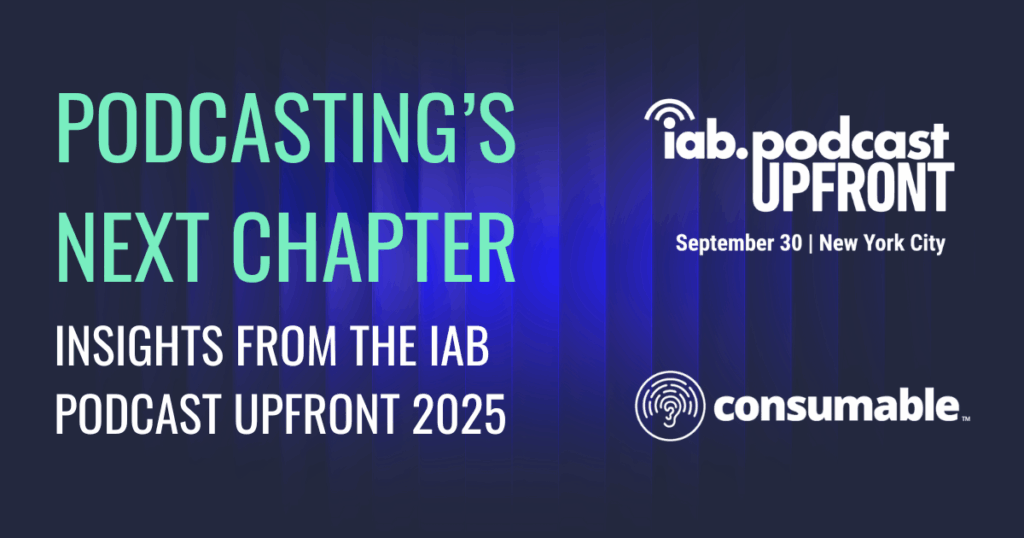From creators and buyers to networks and tech partners, the conversations at this year’s IAB Podcast Upfront painted a picture of a medium in motion.
We were there in the audience, on the stage, and mingling with attendees during the reception afterwards. The optimism was real and so was the candor. Podcasting’s next chapter is unfolding fast, and the forces shaping it were on full display. Here’s what we heard.
1. The $3B Turning Point
Scale brings new expectations.
IAB’s forecast that podcast ad revenue will surpass $3 billion in 2025 was met with an unspoken acknowledgment: That kind of scale demands performance, consistency, and accountability.
Speakers and buyers talked less about potential and more about proof, with the clear implication that podcasting needs to deliver the same rigor and measurability as other major digital channels. The excitement felt grounded and mature. Podcasting has moved beyond chasing validation, and the industry is setting higher standards for itself.
2. The Creator Halo Effect: From Star Power to Scalable Ecosystems
Podcasters are influence engines and culture movers.
Across panels and between sessions, there was real enthusiasm for the creator halo effect. Marketers increasingly view podcasters as full-funnel influencers who can move audiences beyond the episode, through social, live events, and integrated storytelling.
But there was nuance in the air. Some buyers cautioned against over-indexing on individual personalities. The conversation hinted at a shift from star power to audience ecosystems: building reach and engagement across multiple voices and vehicles, and leveraging new tools (like our own PODiQ and TITLE+) to reach podcast audiences across the digital ecosystem.
Influence matters considerably, but scalability, consistency, and context are becoming real currencies of value.
3. Audiences Over Shows
The spotlight is shifting from show sponsorship to podcast audience activation.
While creators remain central, the mood at the Upfront suggested a pivot toward audience-first planning, which was a core theme in our own discussion with Horizon Media. Brands and buyers are looking at where fans listen, not just who they listen to.
Advertisers are looking to harness podcast audiences across platforms and formats, rather than focusing on a single show. This shift from show sponsorship to audience activation is enabled by tools like TITLE+ that allow brands to reach audiences programmatically across the ecosystem. It’s a sign that podcasting’s infrastructure is maturing, from a collection of creators into a true media ecosystem with scalable, audience-based buying.
4. The Measurement Reckoning
“Prove it” was the unofficial theme of the week.
Virtually every discussion, from agency panels to tech demos, circled back to measurement and measurability. Core questions included: How do we quantify value? How do we unify reporting across audio, video, and hybrid formats? How do we access stronger measurement tied to identity?
The appetite for proof is growing faster than the industry’s infrastructure can deliver it, underscoring the need for tools like our own PODiQ that make podcasts addressable. Buyers want incremental lift, attribution, and cross-channel validation, not just download counts and completion rates.
As one moderator put it, “We know podcasting works. Now we need to show how well it works compared to everything else.”
It’s a healthy kind of pressure and one that’s forcing both platforms and publishers to evolve faster.
5. Brand Safety Gets Reframed
Context, not control, is the new conversation.
One of the most quoted moments came from Charlamagne Tha God, who challenged advertisers to rethink “brand safety” frameworks that can silence emerging and diverse voices if they are used as a blunt instrument. His message: Safety should be defined through suitability and context, not censorship.
That sentiment rippled through conversations afterward. Many attendees acknowledged that podcasting’s cultural richness is part of its strength, and that advertisers need tools to navigate nuance rather than avoid it.
For an industry that’s always prided itself on authenticity, this felt like an inflection point and a move toward more intelligent, contextual brand alignment.
6. Format Expansion: Opportunity and Ambiguity
The definition of “podcast” is evolving fast.
Emerging formats like video podcasts, live tapings, and interactive experiences were a big part of the discussion at the Upfront this year. Creators are building multi-format, multi-platform brands.
But even inside the industry, definitions are blurring. The burning question we heard: “At what point is it not a podcast anymore?” It’s both a creative breakthrough and a logistical challenge. One that complicates measurement, ad packaging, and planning.
Regardless, the sentiment was overwhelmingly positive as more ways to engage audiences, means more surface area for innovation. The blurring lines highlight the urgent need for flexible, format-agnostic measurement technology like PODiQ that can track podcast fans wherever they engage.
Where the Industry Goes From Here
Taken together, these conversations confirm that podcasting is at an exciting and demanding crossroads. While its success was built on trust, intimacy, and creativity, its future depends on adding sophistication: data, attribution, and scale. The central challenge is achieving this rigor without sacrificing the very authenticity that defines the medium.
For brands, that means podcasting is more than a test budget or an influencer tactic. It’s clear there is massive opportunity for influence and growth. For publishers and tech partners, it means proving outcomes with the same rigor expected in video, display, or social.
And for all of us building the next wave of audio innovation, it means leaning into intelligence. Understanding not just who listens, but why, when, and how that attention converts, and equipping players across the ecosystem with the right tools.

